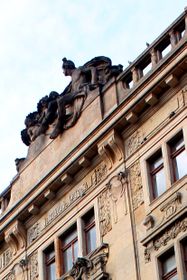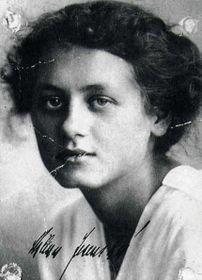Street 28. října 13, Nové Město
 The stately building was constructed as part of a project by the architect Matěj Blecha in the years 1900 to 1902 for a Prague credit union. The style of the building owes much to the neo-renaissance, but the period of the Secession already makes itself felt in the decorative figures and in the rich floral adornment of the facade. A statue of Mercury, the Old Roman god of commerce, and two angels at hi side tower over the balustrade of the five-story (including the attic-floor) palatial apartment house. Presumably Milena Jesenská spent most of her childhood years on the top floor of the elegant apartment building at the lower end of Wenceslas Square in a high-class apartment furnished with dark, heavy furniture. On the first floor her father, a Czech patriot and professor of oral surgery, Jan Jesenský, had his successful dentist-office.
The stately building was constructed as part of a project by the architect Matěj Blecha in the years 1900 to 1902 for a Prague credit union. The style of the building owes much to the neo-renaissance, but the period of the Secession already makes itself felt in the decorative figures and in the rich floral adornment of the facade. A statue of Mercury, the Old Roman god of commerce, and two angels at hi side tower over the balustrade of the five-story (including the attic-floor) palatial apartment house. Presumably Milena Jesenská spent most of her childhood years on the top floor of the elegant apartment building at the lower end of Wenceslas Square in a high-class apartment furnished with dark, heavy furniture. On the first floor her father, a Czech patriot and professor of oral surgery, Jan Jesenský, had his successful dentist-office.
 Milena JesenskáIn 1919, Kafka was introduced to the journalist Milena Jesenská, who came from Prague but lived in Vienna and was married to Ernst Polak. Milena Jesenská showed interest in translating Kafka's story The Stoker into Czech. Soon a lively correspondence ensued and a passionate love affair developed between the unhappily married woman in Vienna and Kafka: “Since I love you…, I love the whole world and to that world belongs your left shoulder, no, it was at the first the right one and that’s why I kiss it, when I want to (and you are so kind as to draw your blouse back from it a bit) and to that world belongs also the left shoulder and your face above me in the woods and face below me in the woods and the weight of your almost uncovered breast on me.”
Milena JesenskáIn 1919, Kafka was introduced to the journalist Milena Jesenská, who came from Prague but lived in Vienna and was married to Ernst Polak. Milena Jesenská showed interest in translating Kafka's story The Stoker into Czech. Soon a lively correspondence ensued and a passionate love affair developed between the unhappily married woman in Vienna and Kafka: “Since I love you…, I love the whole world and to that world belongs your left shoulder, no, it was at the first the right one and that’s why I kiss it, when I want to (and you are so kind as to draw your blouse back from it a bit) and to that world belongs also the left shoulder and your face above me in the woods and face below me in the woods and the weight of your almost uncovered breast on me.”
Kafka’s letters give testimony of a desperate love that could not last: After a short time the paths of the two diverged again. In May, 1920, Kafka complained to his friend Max Brod: “She is a living fire, the likes of which I have never seen before, a fire, by the way, that only burns for him (Polak). At the same time extremely gentle, courageous, intelligent, and she hurls everything into her sacrifice or has, if you wish, gained it by sacrifice. What sort of man, he too, to be sure, who could cause that.”
 At the beginning of 1923 the situation finally became intolerable for Kafka: “The worst at the moment is not, however, - not even I could have expected it – that I can no longer write these letters, not even these important letters. The black magic of writing letters begins and destroy to even greater extent my nights, which already destroy themselves by their own self. I’ve got to stop, I can’t write any longer. Oh, your sleeplessness is a different sleeplessness than mine. Please, don’t write anymore.” Soon afterward the contact between them broke off for good.
At the beginning of 1923 the situation finally became intolerable for Kafka: “The worst at the moment is not, however, - not even I could have expected it – that I can no longer write these letters, not even these important letters. The black magic of writing letters begins and destroy to even greater extent my nights, which already destroy themselves by their own self. I’ve got to stop, I can’t write any longer. Oh, your sleeplessness is a different sleeplessness than mine. Please, don’t write anymore.” Soon afterward the contact between them broke off for good.
Milena Jesenská later became one of the most iridescent personalities in the cultural life of Vienna and Prague. A communist, she agitated against the German occupation forces during the Second World War and was placed in a concentration camp because of it. On May 7, 1944, Milena Jesenská died in Ravensbrück, a concentration camp for women.
